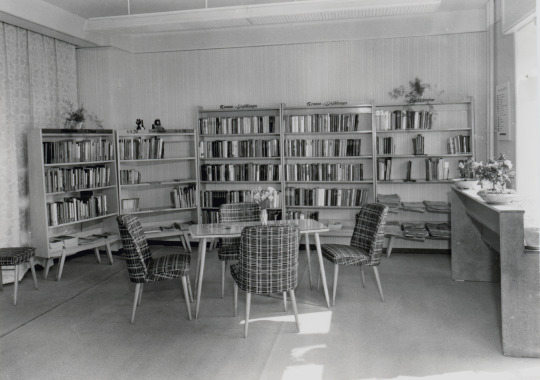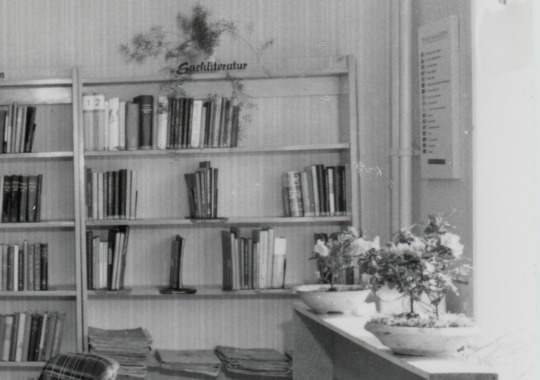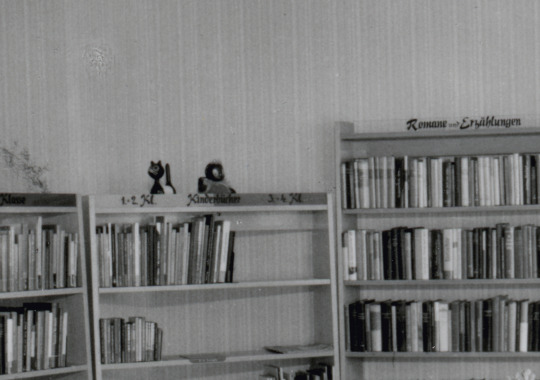#publiclibraries
Explore tagged Tumblr posts
Photo

In the digital era, where information is abundant and accessible, the question arises: are libraries still needed? The answer may lie in how libraries evolve to meet new demands. Beyond books, libraries now serve as access points for digital resources, centers for community engagement, and venues for educational programs. Their ability to adapt to changing times will determine their relevance in the years to come. How can libraries continue to serve as essential community spaces?
#books#libraries#digitalage#communityengagement#education#digitalresources#publicspaces#innovation#librariesofthefuture#learning#knowledge#communitybuilding#publiclibraries#futureofeducation#technologyaccess#lovetoread
12 notes
·
View notes
Video
Library Morning by Lester Public Library Via Flickr: Lester Public Library, Two Rivers, Wisconsin
#365libs#Explore Two Rivers#Lake#lake michigan#Lester Public Library#lesterpubliclibrarytworiverswisconsin#librarian#libraries#librariesandlibrarians#library#libs&libs#LPL#morning#public library#publiclibraries#readdiscoverconnectenrich#TrueToTwo#Two Rivers#Wisconsin#wisconsinlibraries#garden#gardens#librarygarden#librarygardens#flickr
4 notes
·
View notes
Text
The Carnegie hall of Penn Yan
By Jonathan Monfiletto

The philanthropic efforts of steel magnate Andrew Carnegie led to the construction of 1,687 public libraries in the United States of America between 1883 and 1929. Of these libraries, 41 were built in New York State outside of New York City – and 27 of them still operate as public libraries.
Of those libraries, only one is located in the Finger Lakes region – and it stands on Main Street in Penn Yan, within the historic district and just outside of downtown. With a $10,000 grant that Carnegie offered to the community in 1903, the Penn Yan Public Library went up on property that originally contained the Hopkins brothers’ furniture and coffin factory, and the library officially opened in June 1905.
However, efforts to establish a public library in Penn Yan precede the actual building by at least two decades. The Penn Yan Library Club formed in December 1884 with a goal of raising money and purchasing books. The members of the club, as listed in a “History in the News” article by Frank Swan in April 1960, constitute a “who’s who” of the Penn Yan community in the late 19th century. Library Club members would each have a book for two weeks starting on a Saturday, and at the end of that period on a Saturday, they would pass their book on to the next member in line according to a circulating list.
Starting with 26 members, “It was from this club that the inspiration for the Penn Yan Public Library developed and its members who gave the project its necessary impetus,” Swann wrote. The club even hosted fundraisers toward “the avowed purpose of eventually securing for the village the good which would arise from a public library,” a 1957 newspaper article states. This included the Grand Kirmess event at the Sheppard Opera House in February 1898.
Yet, the Penn Yan community’s literary and library interests date back nearly half a century before the Library Club organized and set its sights toward a public library building. According to an unidentified and undated newspaper article from the YCHC subject files – apparently written before the building’s construction, since it states, “Yates county has no library yet,” – the first incorporated association in Yates County, receiving a certificate of incorporation filed in the county clerk’s office, was the Yates County Library Association. The certificate refers to a meeting of 20 people on March 14, 1837. While no more details about the association are given, its trustees comprise another “who’s who” list of Penn Yan.
The Washington Association began by January 1833 as a literary society among the younger businessmen of the village for the purpose of bringing lecturers to Penn Yan to speak on some of the important subjects of the day. The record of its first meeting dates to 1840, so it is believed to have formed seven years before. Some of the speakers who visited the village through the association include Wendell Phillips, Ralph Waldo Emerson, James Russell Lowell, and Horace Greeley. The Washington Association incorporated in 1842 to conduct a public library as well as host literary and scientific lectures, but it seems to have fizzled out as a group by 1857.
When Penn Yan Academy opened in 1859, the principal doubled as the librarian, though that responsibility was later given a faculty member to combine with their teaching duties. However, circulation of the books was limited to the students of the school. According to Swann’s article, a gathering in November 1869 proposed a public library and named managers of such an organization, but nothing substantial seems to have come from that effort.
Penn Yan finally received its own public library in 1895 when the Board of Education allowed members of the Library Club to act as trustees of the Penn Yan Academy library and thus placed the Academy’s 1,400 books into public hands. According to an unidentified typewritten page from the subject files, the Academy library “became the nucleus of a collection,” in July 1895, “and book clubs, individuals and purchases from funds appropriated added to the collection.” At an annual meeting, the Board appropriated $200 for the public library. The public library received a charter on November 21, 1895, and Henrietta Hicks Kimball served as the unpaid librarian until January 1906. Until the library building opened in June 1905, the public library used quarters in the Academy and then – when old Academy was torn down and the “new” Academy built – in the Penn Yan Presbyterian Church, with a little more than 4,000 books moved to the annex of the church in August 1904.
On January 6, 1903, Carnegie offered Penn Yan $10,000 for a library building as long as a suitable site could be provided and $1,000 per year raised to support the library. According to a webpage for the Digital Public Library of America, towns would send requests for funding to Carnegie, and the philanthropist’s gifts were in high demand since few public libraries had dedicated spaces of their own. “Rather than endowing libraries, Carnegie required each town to contribute 10 percent of the annual funding to its library, supply its own building site, and provide free service to the public,” the DPLA states. A newspaper article marking the 70th anniversary of the library’s organizing and chartering notes Hatley K. Armstrong, the first president of the library, wrote to Carnegie in 1902 about the library’s lack of its own building. After “a year of red tape correspondence,” the article states, Carnegie made his offer.
That September, 580 school district residents voted 487 to 93 in favor of accepting Carnegie’s gift. A flyer circulated before the special meeting at which the vote took place – which took place Tuesday, September 15 from 4 to 7 p.m. – residents were being asked to support the library with $1,000 each year through taxation. Since residents were already paying $300 per year to cover the public library at the Academy, the flyer noted, they would now pay an additional $700 if they accepted the gift. That increase would amount to 32 cents per $1,000 of property value, “a trifling amount compared with the additional advantages secured,” the flyer stated. With the average home of the time costing around $3,200, that meant each property owner would pay another $1.02 in taxes each year to have a public library in its own building.
The community raised $300 to purchase the lot on Main Street – nowadays addressed as 212 Main St. –from the Hopkins brothers to place the library there. Albert R. Ross, of New York City, was the architect for the project, while local company Jacob Allington & Sons was the contractor for the work. The ground was broken in October 1904.
A newspaper article dated December 28, 1904 stated in its headline the foundation for the building had been laid and went on to describe what the finished product would look like. The building measured 50 feet along the front with a depth of 40 feet and was made of dark red brick with two courses of Indiana limestone above the ground. “… it is entered from a portico thro [sic] a single broad door, reached by five easy steps, and flanked by two dignified columns and brick piers,” the article stated. “From the vestibule six steps lead to the delivery room, in the center of the main floor, and on each side is a stairway to the basement.” Along with the delivery room were reading rooms, the book stacks with a capacity of 6,000 volumes, the librarian’s room, and the reference room. The basement had an assembly room for lectures, a historical room, and bathroom. The building would be lighted by gas and heated by steam.
“Good progress has already been made with the work, and it is going forward as rapidly as the weather permits,” the article states. “The brick are [sic] laid to the top of the basement windows, and the corner stone is in position.” A copper box was to be placed in the cornerstone containing a copy of the charter of the library; a copy of the letter from Carnegie offering the monetary gift; a list of the names of those who gave money for the building; copies of each of the village newspapers; copies of the petition for the submission to vote and the result of that meeting; a Penn Yan schools catalog; a list of the names of the architect of the building, the contractors, the officers of the library and of the school district and of the village and of the county, the state governor at the time, and the president of the United States at the time.
A dedication ceremony for the Penn Yan Public Library took place on June 22, 1905 at 3 p.m. in the Presbyterian church. The program included a series of music, prayer, Scripture readings, speeches, and presentation of and response to the gifts from Carnegie and other donors. “The library will be open at the close of the exercises, and regularly thereafter,” states a newspaper article listing the program. By the September, the library was open Monday, Tuesday, and Wednesday evenings from 7 to 9 p.m., particularly to accommodate patrons who worked during the day and wanted a place to spend their evenings. Otherwise, the library was open from 2 to 4 p.m. daily.
With a parking lot added in the early 1970s and a building addition opened in the early 1980s – and many changes and improvements along the way – the Penn Yan Public Library continues to serve the community nearly 120 years later.
#historyblog#history#museum#archives#american history#us history#local history#newyork#yatescounty#pennyan#pennyanpubliclibrary#publiclibraries#libraries#andrewcarnegie#philanthropy
2 notes
·
View notes
Photo

From my Mental Floss the Curious Reader Literary Miscellany for Book Lovers calendar
7 notes
·
View notes
Link
#accessibilityinlibraries#DixieConventionCenter#educationconferences#Libraries#libraryinnovation#networkingevents#professionaldevelopment#publiclibraries#St.GeorgeEvents#ULAConference2025#UtahEvents#UtahLibraryAssociation
0 notes
Photo

In the digital era, where information is abundant and accessible, the question arises: are libraries still needed? The answer may lie in how libraries evolve to meet new demands. Beyond books, libraries now serve as access points for digital resources, centers for community engagement, and venues for educational programs. Their ability to adapt to changing times will determine their relevance in the years to come. How can libraries continue to serve as essential community spaces?
#books#libraries#digitalage#communityengagement#education#digitalresources#publicspaces#innovation#librariesofthefuture#learning#knowledge#communitybuilding#publiclibraries#futureofeducation#technologyaccess#lovetoread
0 notes
Text
Museo da Biblioteca Almeida Garret del Palacio de Crystal
Uma exibiçao na biblioteca principal, no mes do May, no dia 11, 2024, foi muito lindo. Un museo (dentro da biblioteca mesmo! Optimo!) con la primera obra así: “No morirá la flor de la palabra “ es increíble. E a ficha explica: “Bordados concebidos pelo Movimento Zapatista.” O adoro. -Nia, fka Shira Injustice Delenda Est ShiraDest publica. Shira Dest. Anto. Jones, MPhil
0 notes
Text
If I had a million dollars to give
Even if I had a million dollars to give, I would prefer to manage it personally. Having witnessed charities and NGOs in action while serving in remote areas, I have my reservations about their effectiveness. I trust my own judgment when it comes to deciding where the funds should go.The money should reach those in genuine need—such as entrepreneurs with innovative ideas, children from…
#CharityConcerns#dailyprompt#dailyprompt-2087#EducationForAll#EffectiveGiving#EntrepreneurSupport#HealthForUnderprivileged#InnovativeIdeas#PersonalPhilanthropy#PublicLibraries#PublicParks#Scholarships
0 notes
Text
Style of reading
I am a monogamous reader. Too many storylines would frustrate me. Reading requires devotion.
0 notes
Text

🏳️⚧️🏳️🌈 Decided to give you EVEN MORE TIME to apply for a $10,000 grant to make things better for LGBTQ+ youth in your community! Apply by May 12th
It's about time for LGBTQ+ youth to take back their power - and we want to help make it happen.
Since 2022, we've awarded over $1.3 million in funding to 142 youth-led projects across the U.S., including things like gender-affirming clothing closets, regional LGBTQ+ youth conferences, student wellness programs and safe spaces, and inclusive arts and education projects.
And yup, your idea could be next. A downtown Pride mural? Education sessions at your local LGBTQ+ center? A Queer Prom? Let's do it!
You can apply now for a grant of up to $10,000 through May 12, 2025 at itgetsbetter.org/changemakers
576 notes
·
View notes
Photo

In the digital era, where information is abundant and accessible, the question arises: are libraries still needed? The answer may lie in how libraries evolve to meet new demands. Beyond books, libraries now serve as access points for digital resources, centers for community engagement, and venues for educational programs. Their ability to adapt to changing times will determine their relevance in the years to come. How can libraries continue to serve as essential community spaces?
#books#libraries#digitalage#communityengagement#education#digitalresources#publicspaces#innovation#librariesofthefuture#learning#knowledge#communitybuilding#publiclibraries#futureofeducation#technologyaccess#lovetoread
1 note
·
View note
Video
Library Morning by Lester Public Library Via Flickr: Lester Public Library, Two Rivers, Wisconsin
#365libs#Explore Two Rivers#Summer#Lake#lake michigan#Lester Public Library#lesterpubliclibrarytworiverswisconsin#librarian#libraries#librariesandlibrarians#library#libs&libs#LPL#morning#public library#publiclibraries#readdiscoverconnectenrich#TrueToTwo#Two Rivers#Wisconsin#wisconsinlibraries#garden#gardens#librarygarden#librarygardens#flickr
2 notes
·
View notes
Text


Join @SanFranciscoPublicLibrary and #SistahScifi on Tuesday, June 10 at 6PM for an unforgettable evening celebrating Octavia E. Butler’s visionary legacy and the power of youth leadership.
Hosted in the James C. Hormel LGBTQIA Center at SFPL’s Main Library and available virtually, this hybrid event honors the fierce brilliance of Lauren Oya Olamina—the teen heroine from Parable of the Sower—and the futures we can build through radical imagination, empathy, and courage.
Moderated by teen author Aida Ndiaye, this event features powerhouse voices including: 📚 Dr. Kendra R. Parker @drkrparker 📚 Dr. Susana M. Morris @susiemaye 📚 Maggie Tokuda-Hall @maggietokudahall
🎟️ Free and open to all ages, register here: https://on.sfpl.org/superhero More info: www.sistahscifi.com/pages/events
Presented in partnership with: @SistahScifi | @sfpubliclibrary | @themixatsfpl | @sevenstoriespress | SFPL's African American Center
#LaurenOlamina #QueerFutures #TeenVisionaries #SFPL
#sistahscifi#octaviabutler#publiclibrary#earthseed#locallibrary#teenvision#parableofthesower#blackscifi
14 notes
·
View notes
Video
A Foreign Language Education – Thai : A language in Southeast Asia
( https://t.co/eNmlTPB2mi)
#foreignlanguage #foreignlanguagetraining #foreignlanguagecenter #foreignlanguagecenter #library #libraries#publiclibrary #publiclibraries #township #county #foreignlanguagespeakers #foreignlanguagesepakers#foreignlanguagestudent #foreignlanguagelearner #foreignlanguagetutor #foreignlanguagelearning#foreignlanguagechallenge #Southeastasia #Thailanguage #LibrarySystem #librarysystems #asuggestpurchase
Reel_A Foreign Language Education
#youtube#foreignlanguage#foreignlanguagetraining#foreignlanguagecenter#library#libraries#publiclibrary#publiclibraries#township#county#foreignlanguagespeakers#foreignlanguagesepakers#foreignlanguagestudent#foreignlanguagelearner#foreignlanguagetutor#foreignlanguagelearning#foreignlanguagechallenge#Southeastasia#Thailanguage#LibrarySystem#librarysystems#asuggestpurchase
1 note
·
View note
Text




Ansichtskarte
Schöne Bibliotheken der DDR Gemeindebibliothek Sommerfeld
Berlin: PLANET-VERLAG, BERLIN (A 4/73 606 F 3023)
Foto: Hillmer
1973
#Sommerfeld#Bibliothek#Bezirk Potsdam#Planet Verlag#1970er#1973#Philokartie#DDRPhilokartie#Bibliotheksphilokartie#Bibliotheksgeschichte#ÖffentlicheBibliothek#PublicLibrary#BezirkPotsdam#LibraryLife#akSommerfeld#AlltagskulturDerDDR#LeselandDDR#Ansichtskartenfotografie#AnsichtskartenfotografieDerDDR#deltiology#VintagePostcard
26 notes
·
View notes
Photo

In the digital era, where information is abundant and accessible, the question arises: are libraries still needed? The answer may lie in how libraries evolve to meet new demands. Beyond books, libraries now serve as access points for digital resources, centers for community engagement, and venues for educational programs. Their ability to adapt to changing times will determine their relevance in the years to come. How can libraries continue to serve as essential community spaces?
#books#libraries#digitalage#communityengagement#education#digitalresources#publicspaces#innovation#librariesofthefuture#learning#knowledge#communitybuilding#publiclibraries#futureofeducation#technologyaccess#lovetoread
0 notes

